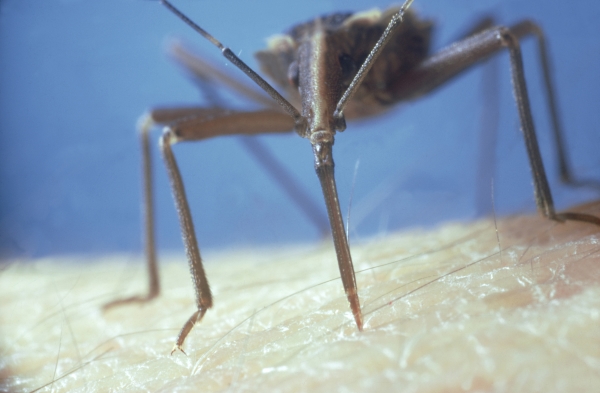What You Should Know About Kissing Bug Disease
 Recent headlines about kissing bug disease have generated both worry and curiosity, raising questions about whether we’re facing a new public health threat. The disease, more formally known as Chagas disease, is caused by a parasite and has now been classified by the Centers for Disease Control (CDC) as endemic to the United States, meaning it’s considered to be consistently present in the country. However, while the news may sound alarming, according to Reeti Khare, PhD, director of the Infectious Disease Laboratory at National Jewish Health, the sudden flood of headlines doesn't mean that we are in the middle of an outbreak.
Recent headlines about kissing bug disease have generated both worry and curiosity, raising questions about whether we’re facing a new public health threat. The disease, more formally known as Chagas disease, is caused by a parasite and has now been classified by the Centers for Disease Control (CDC) as endemic to the United States, meaning it’s considered to be consistently present in the country. However, while the news may sound alarming, according to Reeti Khare, PhD, director of the Infectious Disease Laboratory at National Jewish Health, the sudden flood of headlines doesn't mean that we are in the middle of an outbreak.
What Is the Kissing Bug Disease?
The parasite responsible for kissing bug disease is spread by triatomine bugs, often called kissing bugs because they like to bite near the soft flesh of the mouth and face. The bite itself isn’t usually painful, but the parasite that can be transmitted during the bite can pose a serious health threat. “Sometimes these bugs carry a parasite called Trypanosoma cruzi,” said Dr. Khare. “And that parasite is transmitted not through the bite but through feces. Kissing bugs will often defecate after they bite, and people may rub the parasite into the wound or mucous membranes, allowing it to enter the bloodstream.”
Once in the body, the parasites multiply and spread into different tissues, leading to the disease. “They circulate until they find the muscle tissue they like,” said Dr. Khare. “They’ll sit there and start multiplying. And then they will bust out of the cell and enter the bloodstream where they can spread to other parts of the body. Unfortunately, they love heart muscle.”
The symptoms of kissing bug disease include fever, fatigue, headache and body aches. However, for many, infection causes no symptoms at first. In fact, some people can live with kissing bug disease for decades without experiencing any issues. However, when the parasites multiply in the heart tissue, they can cause serious damage, leading to arrhythmias or even heart failure.
Who’s Most at Risk?
Kissing bugs thrive in warmer climates. “They like tropical and subtropical areas,” said Dr. Khare. “The disease is more prevalent in Central and South America. But it's known to occur in the warm places of the U.S. too, specifically the Southern U.S.”
Texas has had the most cases of kissing bug disease. However, cases have also been reported in Arizona, California, Louisiana and Mississippi, among other states with warmer climates. However, the disease is rare, affecting approximately 280,000 people total in the U.S., and, despite recent headlines, there hasn’t been a surge of cases.
Is the Kissing Bug Disease New?
Kissing bug disease is not new to the United States. “It's been endemic for a long time,” explained Dr. Khare. “This is just the first time that we are labeling it as endemic.”
In other words, the CDC’s designation hasn’t changed the reality of the disease itself, even while sparking a flurry of panic-inducing headlines. The reason for the change is to encourage more cases to be reported to health authorities. Diseases that are and are not reportable can vary. For instance, Dr. Khare noted that there are other, far more common infectious diseases that haven’t been given the same treatment: “For example, nontuberculous mycobacteria have been around for a long time. It’s ten times more prevalent than tuberculosis. And it's still not reportable in all states.” So, while kissing bug disease should still be a concern if you have symptoms and are in an at-risk area, the U.S. isn’t expected to experience an epidemic of the disease anytime soon.
Should You Get Tested?
Testing for kissing bug disease is not recommended in most cases, as for the majority of Americans, the risk of infection remains very low. In areas where kissing bug disease is more common, routine blood draws will often involve a screening for the parasite. “For a disease like this, especially in the years or decades when there are no symptoms, there’s also a risk of over-testing,” Dr. Khare explained. “If you get a false positive, for instance, that may cause doctors to get tissue biopsies from sensitive areas, such as those around the heart muscle, and those procedures come with risks.”
Making Sense of the News
While the “kissing bug disease” news may be attention-grabbing, Dr. Khare has urged calm. The disease is real, but rare. And it has been present in parts of the U.S. for decades. “Nothing new is happening,” said Dr. Khare. “It's just in the news because of the designation, and many people are hearing about it for the first time. So while awareness is important, panic is not.”
Published September 2025
